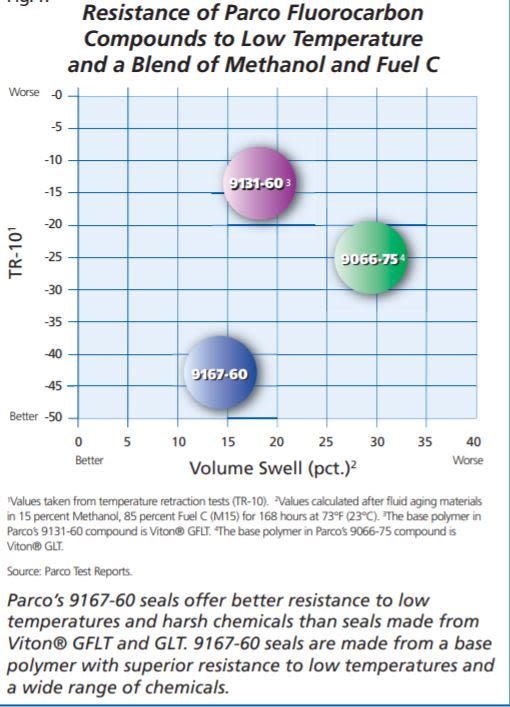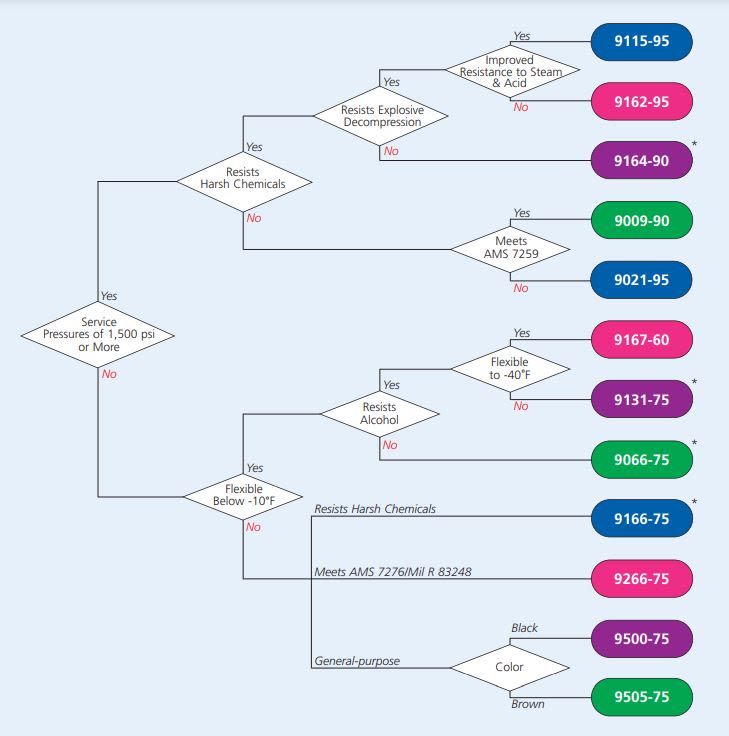Knowde Enhanced TDS
Identification & Functionality
- Chemical Family
- Polymer Name
- Technologies
- Product Families
Features & Benefits
- Materials Features
- 9167-60 Meets Your Needs
Superior Performance at Low Temperatures Seals made from 9167-60 can be used in applications with continuous service temperatures as low as -40°F. Parco’s chemists have formulated a compound with a base polymer that features better low-temperature flexibility than compounds made from existing Viton® GLT and GFLT materials. Parco’s 9167-60 compound has a TR-10 value of -43°F, making it superior to most fluorocarbon compounds (see Figure 1).
Excellent Resistance to Harsh Chemicals Parco’s 9167-60 compound offers superior performance in harsh chemical applications compared to compounds made from Viton® GFLT. Fluorocarbon is naturally resistant to a wide range of chemicals due to the elastomer’s high ratio of fluorine to hydrogen, the natural strength of the carbon-fluorine bond, and the absence of unsaturation in the carbon bond. The base polymer for Parco’s 9167-60 compound has a fluorine content of 67 percent. That high fluorine content gives our compound increased chemical resistance. Our 9167-60 seals had volume swell of less than 10 percent after prolonged exposure to standard reference fluids.
- Can Your Fluorocarbon Seals Handle -40°F?
Exposure to low temperatures and harsh chemicals can cause seals to crack or swell. Whether your seals are used in applications such as automotive fuel systems or aerospace hydraulic systems, your seals need to prevent leakage.
Applications & Uses
- Applications
- Cure Method
- Plastics & Elastomers End Uses
- Chemical Resistance
USE WITH DO NOT USE WITH - Carbon Tetrachloride
- Diester Synthetic Lubricants
- Gasoline
- Hot Air
- Toluene
- Acetone
- Amines
- Ethyl Acetate
Properties
- Chemical Resistance
- Color
- Physical Properties
| Value | Units | Test Method / Conditions | |
| Hardness | 58.0 | Shore A | D2240 |
| Tensile Strength | 1621.0 | psi | D412 |
| Ultimate Elongation (pct) | 202.0 | — | D412 |
| Modulus (100 pct, Elongation) | 488.0 | psi | D412 |
| Compression Set 22 hours (200°C, 392°F ) Pct of Original Deflection | 15.0 | — | D395 |
| Heat Aging 70 hours (250°C, 482°F) Hardness Change, pts. | 1.0 | Shore A | D573 |
| Heat Aging 70 hours (250°C, 482°F) Tensile Strength Change, pct. | -1.0 | — | D573 |
| Heat Aging 70 hours (250°C, 482°F) Ultimate Elongation Change, pct. | 14.0 | — | D573 |
| Fluid Aging, Fuel C 70 hours (23°C, 73°F) Hardness Change, pts. | -5.0 | Shore A | D471 |
| Fluid Aging, Fuel C 70 hours (23°C, 73°F) Tensile Strength Change, pct. | -8.0 | — | D471 |
| Fluid Aging, Fuel C 70 hours (23°C, 73°F) Ultimate Elongation Change, pct. | -1.0 | — | D471 |
| Fluid Aging, Fuel C 70 hours (23°C, 73°F) Volume Change, pct. | 6.0 | — | D471 |
| Low Temperature Flexibility TR-10°C (°F) | -40(-40) | °C(°F) | D1329 |
Regulatory & Compliance
- Certifications & Compliance
Technical Details & Test Data
- Technical Details

- Technical Details

Parco’s fluorocarbon seals provide excellent resistance to a wide range of chemicals and temperatures. This selection diagram will help you choose among Parco’s popular fluorocarbon compounds. Parco also offers more than 40 fluorocarbon compounds not shown in this diagram. If we don’t have a compound for your application, we can develop one for you.